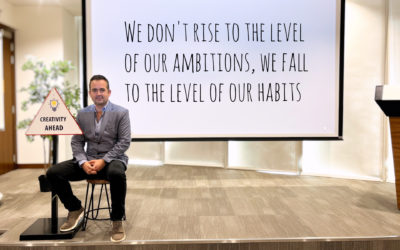What are the Basic Concepts of AI That Modern Leaders Should Understand and Why is it Important for Them to Stay Up to Speed, Even If They Are Not Technical? Estimated reading time: 8 minutes Understanding AI Fundamentals: Essential for informed decision-making. Key...
While most of us are trying to anticipate the world of 2021 – a tough enough challenge as it is – there’s a longer view to be considered if associations are not only to survive but thrive by 2030.
Much of this future success will be shaped by decisions and plans set into motion this year and next year, decisions that will reverberate for many years to come and are therefore important to get right.
As you would probably expect a technologist to say, that success will to an ever-growing extent be predicated on the adoption and implementation of technological solutions. The notion that digital transformation is now no longer a matter of taste or inclination, but a precondition for survival, is I suspect now well-established and accepted. 2020 certainly took care of that.
The challenge now is in finding the balance between doing nothing and ‘jumping the gun’ by throwing every shiny new tech tool at the problem in the hopes of success or just to be seen doing something proactive; neither will serve you in the longer term. Entropy is a reality in business life too; it will be very hard to undo decisions made in 2020 ten years from now, just as you can’t unscramble an egg.
So what’s an association executive to do without the benefit of a crystal ball? How do you hit an invisible, moving target?
Part of the answer is to look forward and rather than try to anticipate technologies, anticipate the trends that dictate the emergence of specific technologies. When you understand the broad strokes of this unfolding transformation on a societal level you can pull focus on the technologies we can expect to see flourish ten years from now.
SMALL TALK
Even before Covid there was a growing trend towards smaller-scale communities. Arguably Facebook’s most successful features are now not the general social media interfaces and content delivery mechanisms, but groups. Both on WhatsApp and Facebook itself, private groups have been booming and show no sign of slowing down.
After a high-paced decade of generalist platforms where everyone could see everything, there is now a pronounced shift towards niche interest groups where smaller groups of people engage on very specific topics dear to them. When you open WhatsApp, chances are very high you’re engaging in groups, and the same is true for Facebook and every other social platform.
It is highly likely this trend will continue into this decade as more and more technology will be created to cater for the needs of smaller units, even within associations. So rather than looking forward to large-scale conferences with thousands of people being the norm, anticipate a multitude of smaller events taking place more frequently to address the needs of smaller circles of people.
On a technological level that transition means that you should make sure that you have the technological capabilities to run a multitude of ‘pop-up’ events throughout the year, both face to face and virtual, or hybrid. It also means that you should start the process of identifying those subsegments of your overall community now so that you can start the process of adopting solutions that are capable of managing communications with a wide range of divergent subgroups.
THE AGE OF ME
Segmentation as described above is not just taking place on a macro level, it is increasingly becoming the norm on a micro level, the level of you as an individual. Personalization is the Holy Grail of just about every technology-driven industry in the world and this trend is accelerating every year.
Already, an Apple Watch can monitor your health and provide physicians with a unique blueprint of your overall condition for tailored healthcare. Even today you can get cars, furniture, clothing, and a host of other goods designed, made, and delivered to your exact specifications and wishes. Ten years from now, there will be few products or services of value that are not customized to fit our individual needs.
Let there be no doubt that this reality will trickle into the associations world as well. Your future delegates and members will not be content with receiving the same bulk email newsletter as every other member, it had better be aimed at his or her specific interests. As a matter of fact, serving your delegates the same content in any context will be a dealbreaker, including at events and conferences.
How does that tie in with technology? Well, in a very profound way. While more and more people will pull away from traditional social media platforms that harvest their data and turn them into sellable commodities, many people will be happy to share data with trusted organizations and closed communities if that transaction is balanced and leads them to receive a deeply considerate and personal experience.
While always prioritizing privacy and wellbeing, you need to start capturing data, lots, and lots of data. You need to start logging everything, everywhere, all the time. As this big data cloud swells over time, ever-improving algorithms will allow associations to detect patterns and correlations that will in turn drive major business decisions but also allow for deep personalization. When you can serve your members exactly what they want, when they want it, your loyalty and retention rates will skyrocket.
This is a major shift in the way organizations think but it is crucial. If your CRM is still filled with fields that only collect data like addresses, countries, or whether the member wants to opt-in to email, you’ll be in trouble by 2030.
You can witness the emergence of technologies that leverage this trend already. One of the buzzphrases of this year has been ‘algorithmic matching’, a concept that implies letting an AI-driven system decide who you should meet at events based on a large set of data points.
Personalization is the battleground of this decade, make sure you are in that fight.
NOTHING TO SEE HERE
The final trend I’d like to draw your attention to is the advent of ‘invisible’ technology. One prediction futurists of the past consistently got wrong was to commonly anticipate very sophisticated but physically large machines and utilities. Robots, talking fridges, jetpacks, and flying cars are some well-trodden ideas along those lines.
But in reality, the most promising and successful technologies are those that are quite literally disappearing right in front of our eyes. Sensors embedded in a relatively small wristwatch will be the guardians of your health. A smart speaker the size of a hockey puck already has the ability to control your appliances and play music at your command. Very soon the advent of Augmented Reality glasses (Facebook and Apple are just two high-profile players in this space) will allow us to conjure entire worlds into our field of vision.
5G will accelerate this trend drastically. Everything can and most things will have sensors. The so-called Internet of Things will become a reality and to a large extent release us from having to hold and manipulate physical interfaces to trigger desired actions.
Why is this relevant to associations? Because new generations of people will enter the workforce who won’t have any patience or tolerance for ‘old school’ interfaces, like good old websites the way we still view them today, for example. Minimalism in interface design will be the norm and presenting people with too many options, buttons, toggles, and switches will be as bad as having no interface at all.
This isn’t a new trend. Place an iPhone next to a Blackberry from 2010 – then a state of the art communications device – and this reality will become glaringly obvious. Lots of buttons and switches on the latter, almost no buttons at all on the former. Your phone probably doesn’t have a headphone port, and your headphones no cables. You’re scanning QR codes to order food at restaurants instead of holding menus, or you tap three buttons on your phone to have it delivered to your home.
IN CLOSING
There’s everything to play for and the odds of your associations having a much larger audience in the future are in your favor, but that outcome is directly determined by the decisions you make in the short term. It will be infinitely harder in five years time to catch up or change direction, so grab this one by the horns and 2030 will be one to remember for all the right reasons.








